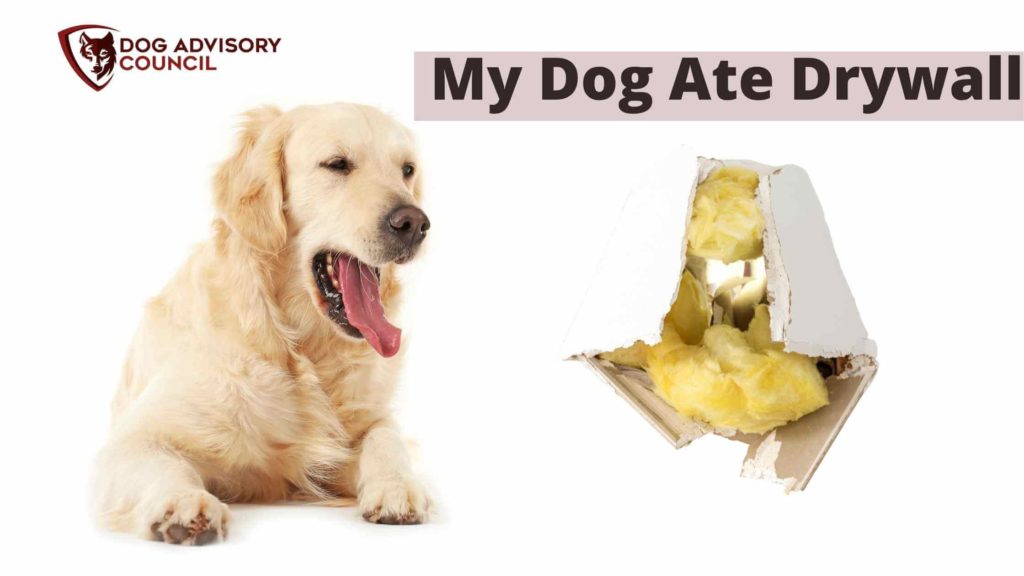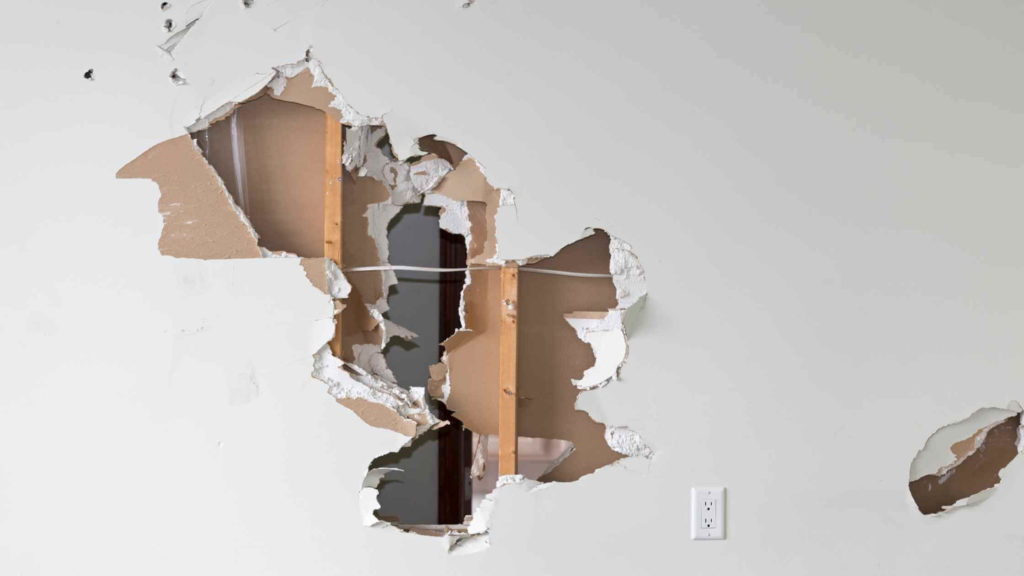
Dogs are always eating what they shouldn’t. Here’s what you should know if you found your dog ate drywall.
If your dog ate drywall, you’ll be happy to learn that drywall in itself isn’t toxic — the gypsum is non-toxic. However, drywall can cause respiratory issues or cause an intestinal blockage — which can be a fatal reaction in some cases.
A trip to the vet is a good idea just to see how much your dog actually ate.
Can dogs get sick from eating drywall?
In most cases, dogs won’t get sick from eating drywall. The drywall itself, also called gypsum or sheetrock, is non-toxic and is just gypsum compressed into sheets. However, dogs can get sick with respiratory issues or intestinal blockages.
Since drywall is dusty, this dust is inhaled. It can leave your dog with short-term or long-term respiratory issues, depending. It will depend on how much they ate and how long they were exposed to it.
A blockage is a short-term complication that is as literal as it sounds — a blockage in your dog’s throat or intestine. It can impact breathing or digestion, and it is an emergency that needs to be fixed as soon as possible.
Unlimited claims, No credit checks, No upper age limit & Multiple pet discounts
Compare the best rates on pet insurance
Why is my dog eating drywall?
Dogs have the strangest appetites, right? Dogs will commonly eat drywall because it feels neat in their mouth. A dog’s mouth is their hands, remember, so dogs will chew up some drywall just to see what it is.
It’s also essential to distinguish between chewing up the drywall and swallowing — aka eating — it. Many pet parents will worry about their dog eating drywall only to find out that dogs just crunch it up in their mouths and spit it out again, thoroughly satisfied.
If you see lots of pieces around and your dog is otherwise fine, it’s very possible that they just checked it out with their mouth and spat it out again. Of course, you’ll always want to assume the worse and hope for the best.
Is drywall dust toxic to dogs?
The dust from drywall isn’t toxic, but it can be dangerous to dogs. It will clog their mouths, noses, and throats in a thick coating. This can cause them to cough, sneeze, and struggle to breathe properly.
Depending on how much they ate, it can cause respiration issues. If your dog already has respiration issues, this will worsen them. These should go away after your dog clears themselves out, but sometimes they can linger for a while. However, sometimes an application on drywall can cause issues. More on that later.
Is drywall poisonous to dogs if eaten?
Traditional drywall isn’t poisonous for dogs since its gypsum isn’t harmful in its ingredients. It isn’t considered poisonous if it’s pure, classic drywall that your dog’s eaten.
However, there are complications possible from what’s called Chinese drywall. This is long outdated, but some of it is floating around in houses. This contains an active ingredient called pyrite. This is dangerous because the longer a dog is exposed, the worse the symptoms get. This is toxic and can be fatal.
If you live in a home with Chinese drywall, it could be a problem for your dog’s health and general safety.
Symptoms to look for if your dog has eaten drywall
If you feel as though your dog has eaten the drywall, rather than just chewed it up and spat it out, you’ll want to look for the following symptoms:
- Coughing
- Gasping for breath
- Panting
- Drinking excessively (or not at all)
- Lack of appetite
- Diarrhea
- Vomiting
- Signs of distress
If you notice any or all of these signs, you’ll want to call your vet or just bring them right in. These all indicate a respiratory or an intestinal blockage, and the sooner you get it looked at, the better your dog’s chances are at recovery.

What should you do if your dog ate drywall?
If you feel panicky about your dog eating drywall, it’s okay! It’s a terrifying moment, and it’s normal to feel unprepared. Here’s what to do:
- Check to see if they ate it or just chewed it up
- Stay calm and comfort your dog
- Call your vet and follow their advice
- Watch, and react to, any symptoms
Check to see if they ate it or just chewed it up
As mentioned, many dogs will simply check it out and spit it out! So, compare the drywall with the pieces on the floor and see if you are missing any pieces. If you aren’t, the odds are that your dog will simply have some mild respiratory issues at the worst. If you are missing chunks, you’ll need to prepare for respiratory or intestinal blockages.
Regardless, you’ll need to be on the lookout for your dog’s health for 24 hours or so just to be on the safe side.
Stay calm and comfort your dog
Your dog will be upset and confused if you are upset and confused. The best thing you can do is keep yourself calm and offer your dog comfort and relaxation. This is especially important if you notice a few symptoms and try to prepare yourself for the next step.
Call your vet and follow their advice
Your vet should know about your dog’s drywall adventure, even if you are not noticing any kind of symptoms. They’ll offer some advice such as feeding them a bland diet, watching their bathroom habits, etc. Some even just recommend that you bring them in for a check-up to be sure.
Whatever it is that your vet recommends, you’ll want to take them up on their offer and recommendation.
Watch, and react to, any symptoms
Symptoms can be immediate or delayed for several hours. Even up to 24 hours, in some cases. You’ll want to carefully note any symptoms and be prepared to bring your dog in for a vet appointment if needed.
Your vet will often set an emergency slot aside for you just in case. It’s essential to bring your dog in as soon as you notice these symptoms, as time is an issue — don’t wait until the next business day!
What happens if my dog eats plaster?
The plaster will react in your dog the same way as drywall or sheetrock! So, watch for the same complications and symptoms.
What happens if my dog eats paint off the wall?
As if things couldn’t get any weirder, right? Dogs can often eat walls with paint on them. The wall material itself should be fine, but the paint can be a problem. This is a chemical-based and hazardous product, and it can cause a toxic reaction in your dog. If your dog’s eaten paint off a wall, take him to the vet.
What should I do if my dog ate spackle?
Spackle is in the same category as plaster or sheetrock. You’ll want to keep an eye on possible indigestion and blockages, though it won’t be quite as common since dogs don’t eat large chunks of it the same way as sheetrock.
My dog ate drywall and has diarrhea now: what does it mean?
It mostly depends on whether or not your dog has other symptoms. Diarrhea by itself is often due to the dog trying to push this material out of its body. It could be a sign that they are successfully pushing it out. However, diarrhea with vomiting or other symptoms from above means that there could be a blockage. Bring them to the vet.
Should I take my dog to the veterinarian?
Vets are expensive, so it’s standard if you’re wondering this. While taking your dog to the vet isn’t necessarily a must-do, it’s a very strongly-recommended option. You definitely will want to prepare yourself for it, even if you decide to wait and see if symptoms develop.
How to stop my dog from eating drywall?
Since there is drywall all over your house — literally — stopping your dog from eating drywall is as much about curbing boredom or stress as keeping them away from sheets of it on construction sites.
Drywall will never be more appealing than a tasty morsel of human food. However, boredom or stress can cause dogs to eat walls in your home as a coping mechanism.
How to prevent my dog from eating drywall
As far as prevention, if your dog is exploring a construction site, for example, it’s going to come down to the following details:
- Obedience training
- Restricting access to drywall
- Attend to their needs as much as possible
A dog that obeys commands that you give them is a dog that will stop eating sheetrock as soon as you tell them to. When exploring a construction space, see it through their eyes and restrict access to it. If you need to use a leash to do so, do it!
When it comes to that boredom chewing of your wall, you’ll want to prioritize understanding your dog’s need for stimulation and play. This will help them rest peacefully when left alone, and rest rather than eat your wall!
In short
Discovering that our dog ate drywall is alarming, to be sure, but it’s not the worst thing ever.
Made of gypsum, drywall is not toxic to your dog. If they eat it, you will need to watch for breathing or intestinal blockages more than toxic reactions from chemicals.
A trip to the vet isn’t required unless you see symptoms, but it is a great idea to think about! Just monitor for symptoms and be ready to take them to the vet!
Know someone who can use this education? Share it with them!
Unlimited claims, No credit checks, No upper age limit & Multiple pet discounts
